Texas, the second-largest U.S. State has a ton of snake species — at last count the total was around 80. So, wherever you go within the Lonestar State, there’s a good chance you’ll find several snakes — the Guadalupe River is no exception.
Beginning in Kerr County, Texas, the Guadalupe River’s course flows 230 miles. It winds through hills and flatlands before draining into San Antonio Bay on the Gulf of Mexico. The river has everything from limestone banks to whitewater rapids. You can also find ancient bald cypress trees in the upper section, and go tubing or fly fishing in some sections of the river.

Whether you like whitewater rafting or a leisurely float down the river, the Guadalupe River has something for you.
©JaDipity/Shutterstock.com
Plain-Bellied Watersnake(Nerodia erythrogaster)
This harmless species with a slightly goofy-looking face is often confused for venomous cottonmouth snakes. Plain-bellied watersnakes are common in and around the Guadalupe River and use their razor-sharp teeth to catch fish and amphibians. However, even though they’re harmless, those teeth hurt! When cornered, this species bites early and often.
Adult plain-bellied watersnakes are about four and a half feet long and have keeled scales and vertical lines along their lips.

Plain-bellied watersnakes lose their juvenile pattern and become almost black with small remnants of their pattern.
©iStock.com/lbolton09
Diamondback Watersnake (Nerodia rhombifer)
This plain-bellied watersnake cousin usually grows to about five feet long. Their pattern, reminiscent of a chain-link fence, forms diamonds down most of their backs. Diamondback watersnakes have keeled scales but aren’t as heavy-bodied as plain-bellied watersnakes. Additionally, their pattern doesn’t diminish as much as they age.
They also have vertical bars (called labial bars) along their lip. It’s an easy way to distinguish between a cottonmouth and a harmless watersnake. Diamondback watersnakes are relatively common around the Guadalupe River, where they’re often seen dangling above the water, waiting for a tasty fish or frog to swim underneath.

Diamondback watersnakes often bask on logs and branches at the water’s edge.
©Laurie L. Snidow/Shutterstock.com
Coachwhip (Masticophis flagellum)
Although not water-loving snakes like a few others, coachwhips aren’t uncommon near water. These long, thin snakes are somewhat closely related to racers, and in fact, were once included in the same genus. However, these snakes get their name from the patterning on their scales, especially in the back half of their body – it looks like a braided whip.
Coachwhips are fast-moving snakes that are known snake eaters, sometimes venomous, and for a particular behavior they exhibit. Called periscoping by many, coachwhips often slither along with their heads above the long grasses they prefer to inhabit. They have large eyes, excellent vision, and an inquisitive nature.
Long and thin, adult coachwhips can reach seven feet long, but most stay smaller. They’re harmless snakes that help take care of the rodent population along the Guadalupe River.
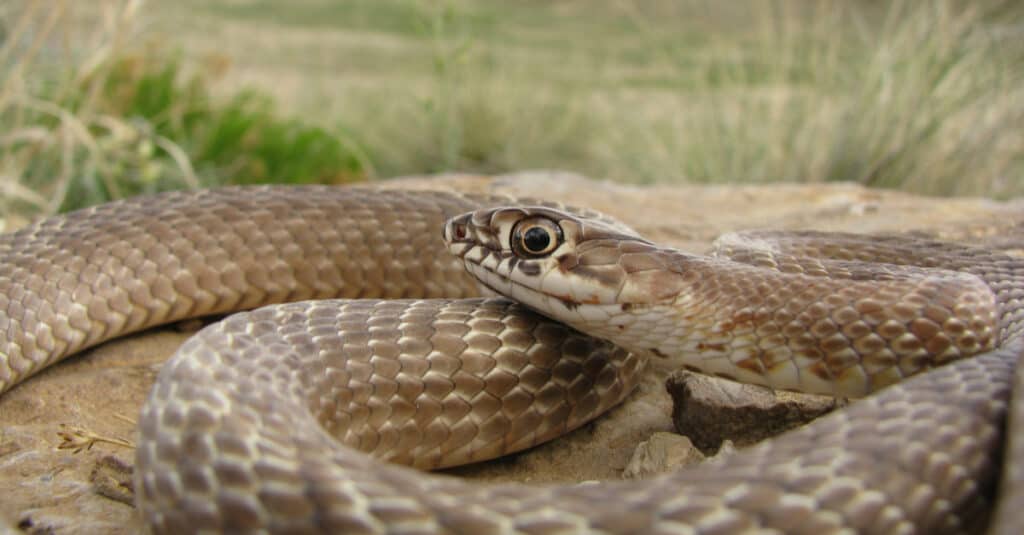
Coachwhip snakes are non-aggressive snakes and non-venomous, but startle people when they periscope up from tall grasses.
©Joe Farah/Shutterstock.com
Texas Ratsnake (Pantherophis obsoletus lindheimeri)
It’s actually hard to tell this western ratsnake subspecies from the others, so most of the time people simply call it a western ratsnake. However, Texas ratsnakes are different enough to be a subspecies and have a couple of visual differences from other western ratsnakes — the biggest difference is the gray head on Texas ratsnakes.
Regardless of which subspecies you encounter, ratsnakes are semiarboreal and excellent climbers. They grow up to five feet long or so and are muscular snakes with a blotchy pattern. You’re more likely to spot them in the trees around the Guadalupe River rather than on the ground.
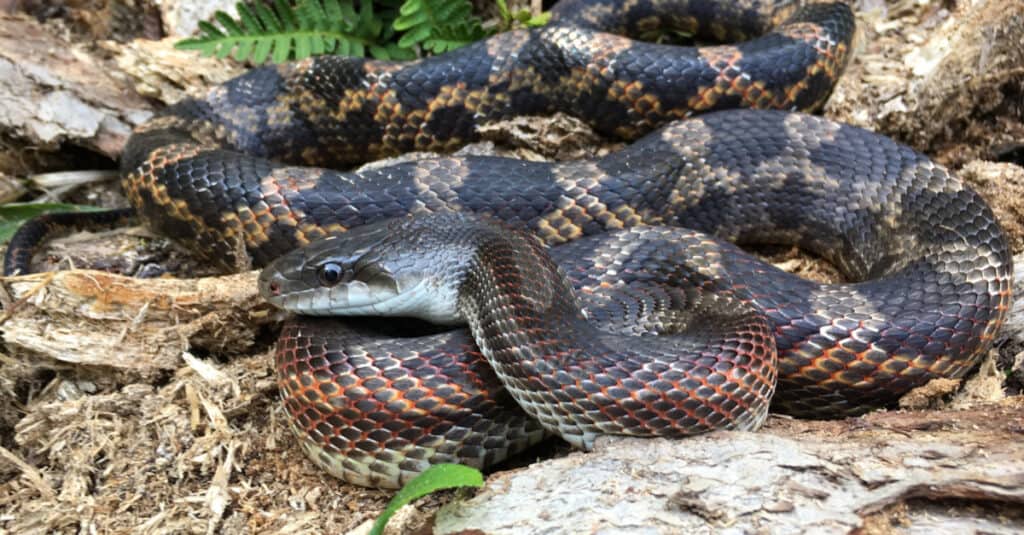
Texas ratsnakes are a subspecies of western rat snakes that come in many colors but darken with age and lose some of their patterns.
©Joe Farah/Shutterstock.com
Western Ribbon Snake (Thamnophis proximus)
This garter snake loves water, just like other garter snake species. Western ribbon snakes are semi-aquatic and mainly feed on amphibians and their tadpoles; they also feed on lizards and fish. Noticeably thinner than other garter snake species, western ribbon snakes have clearly defined stripes down the length of their bodies. They are relatively common along the Guadalupe River and grow up to 30 inches long.
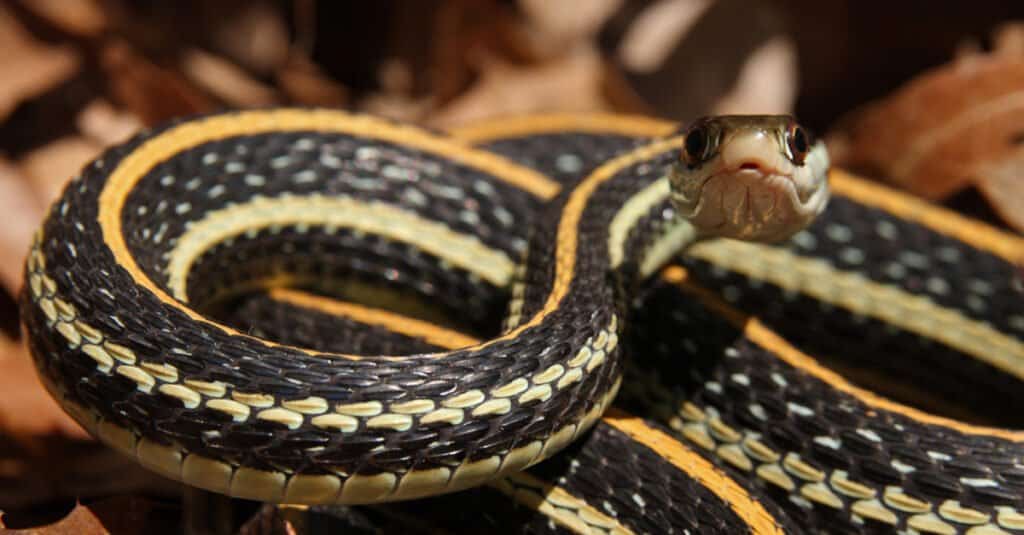
Western ribbon snakes have clearly defined longitudinal stripes along their bodies.
©Ryan M. Bolton/Shutterstock.com
Black-Necked Garter Snake (Thamnophis cyrtopsis)
Black-necked garter snakes have distinctive black markings on their necks. They usually have an orange or yellowish dorsal stripe. Like other garter snakes, they feast on small prey like fish, amphibians, and earthworms in their wet habitat.
These snakes are harmless and somewhat common along the Guadalupe River. Black-necked garter snakes can grow to 42 inches long and are most commonly found near the water.
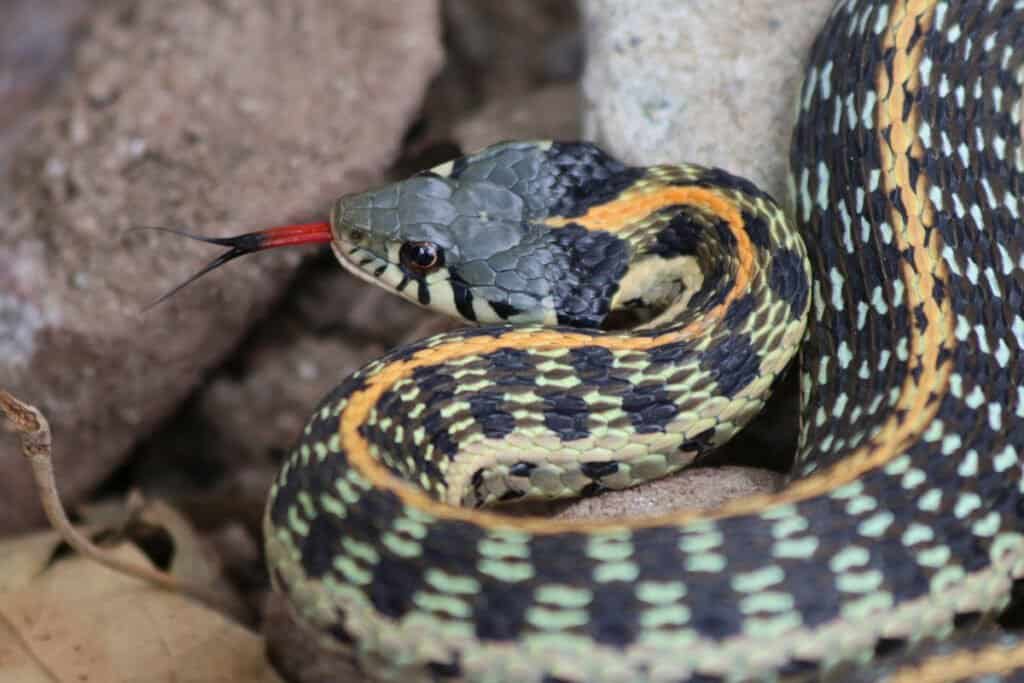
Black-necked garter snakes eat various fish, amphibians, and insects.
©Creeping Things/Shutterstock.com
Checkered Garter Snake (Thamnophis marcianus)
Also called Marcy’s garter snake, checkered garter snakes have well-defined checker-board patterns on either side of their dorsal stripe. They can get to 42 inches long as adults but usually measure 18 to 24 inches. Checkered garter snakes are native to the southwestern U.S. and don’t venture farther east than the Guadalupe River, where they’re common snakes.
These snakes have similar diets as other garter and ribbon snakes, mainly eating earthworms and amphibians.
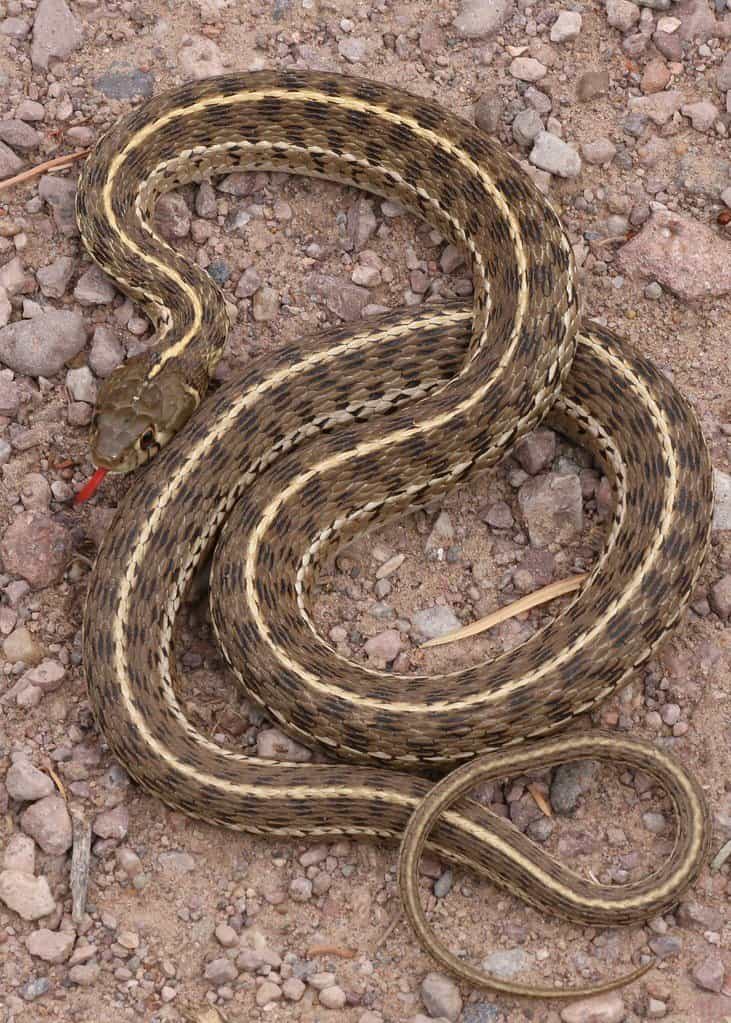
Most checkered garter snakes reach a maximum of 18 to 24 inches long.
©
Eastern Hognose Snake (Heterodon platirhinos)
These are some of the cutest snakes. Seriously! If their defensive antics didn’t make you love them, a hognose’s adorable little snout will. Eastern hognose snakes can get to four feet long but usually measure around two feet long. They have blotches down their backs with smaller blotches on the sides. Some are so dark you can’t see the pattern, but their cute little snout is easy to spot.
These snakes are more prevalent in areas where the soil is loose and sandy. They love burrowing and digging around to flush out their favorite food: toads! If you see an eastern hognose snake it’s a treat.

They’re known for dramatic defensive displays, but hognose snakes are harmless to humans!
©IHX/Shutterstock.com
Rough Earthsnake (Haldea striatula)
Small and fossorial, you may never see one if you float down the river in a tube. However, hiking along the leaf-litter-covered trails may give you a chance to see one. Rough earthsnakes are small and many people mistake them for Dekay’s brownsnakes until they look closer.
They only measure about 10 inches long as adults and eat slugs, snails, and other soft-bodied arthropods. Rough earthsnakes live all along the Guadalupe River.
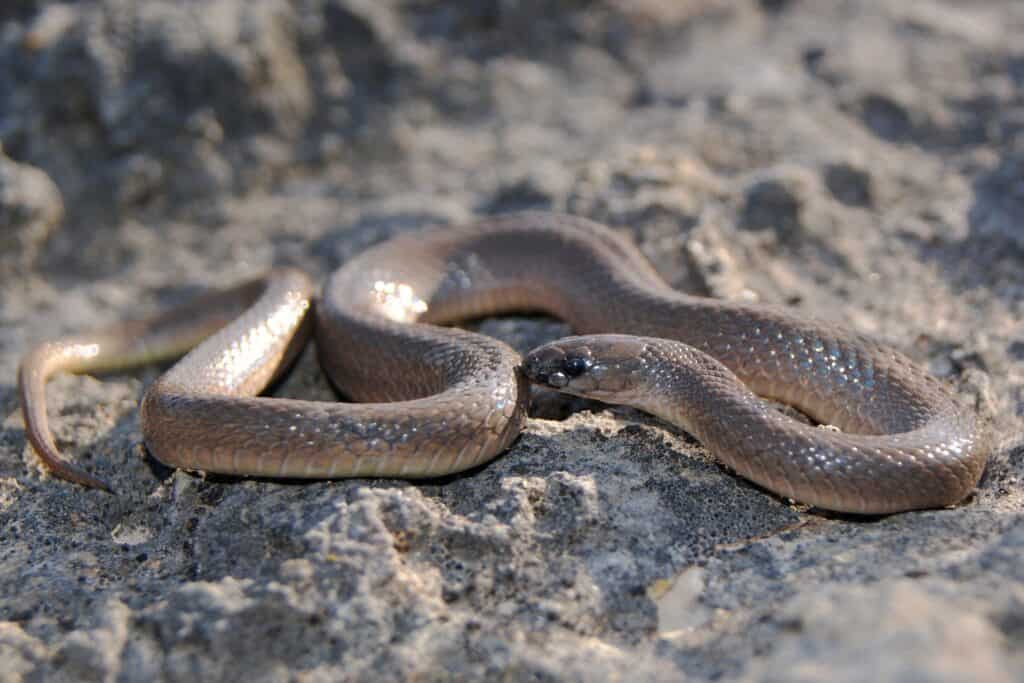
Rough earth snakes eat snails and slugs; they almost never bite people.
©Matt Jeppson/Shutterstock.com
Texas Blind Snake (Rena dulcis)
This snake spends almost all of its life underground, hunting insect larvae, termites, and ants. Texas blind snakes have also been found in screech owl nests, eating ants and other parasites.
Texas blind snakes have no eyes or teeth. These snakes are completely harmless and sometimes get confused for worms until you look closer. They are only about 10 inches long and not as common as other snakes along the Guadalupe River. However, that doesn’t make it impossible to find one!
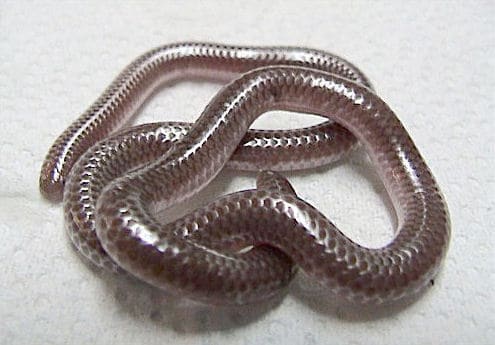
The Texas blind snake looks like an
earthworm
at first sight.
©LA Dawson / CC BY-SA 2.5 – License
Texas Patchnose Snake (Salvadora lineata)
Primarily in the upper section of the Guadalupe River, Texas patchnose snakes are thin and could be confused with ribbon snakes. These snakes usually grow to about three feet long and have a modified scale on their snout that they use for burrowing in loose soil and leaf litter. It looks like a patch on their nose, hence their name.
Texas patchnose snakes have striped bodies. It’s hard to tell where the base color ends and the stripes begin — dorsally, they have one light-colored stripe and a thick, dark-colored stripe on either side. Lower on their sides, another light stripe next to a thin dark one. Colors are usually shades of brown, tan, or gray. Not much is known about this patchnose snake species. However, if it is similar to others of its genus, Texas patchnose snakes likely eat various small mammals, reptile eggs, grasshoppers, lizards, and other small prey.
They’re completely harmless, but quick-moving. If you’re trying to get a great photo, it probably won’t be easy.
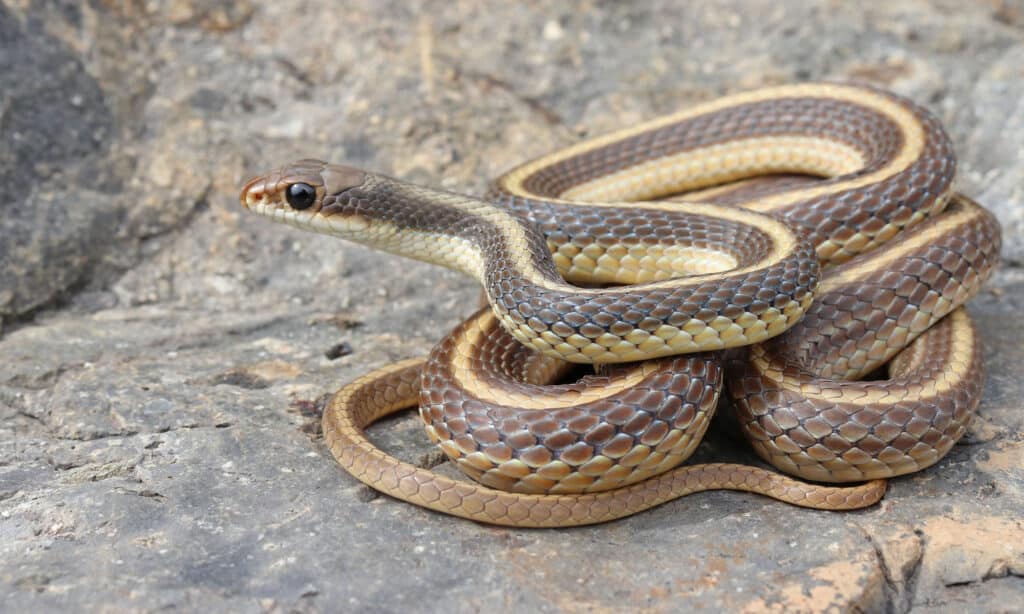
Patchnose snakes, like this western patchnose, have a modified scale on their snout.
©Creeping Things/Shutterstock.com
Venomous Snakebite First-Aid
Medical professionals have learned a lot about what not to do when someone is bitten by a venomous snake in the U.S. For many years, the recommended approach was attempting to suck out the venom. Don’t do this. It doesn’t work and may cause more damage.
Here are a few more things to avoid in the case of a rattlesnake bite:
- Do not use a tourniquet
- Do not ice the bite location
- Don’t attempt to suck out the venom with your mouth or a suction device. Even if you tried to suck out the venom, you would only get about 1/10,000th of the venom injected.
- Don’t make any incisions over the wound.
There are roughly 8,000 venomous snakebites annually in the U.S. Of these, only a few cause fatalities. A few simple snakebite tips will help you reduce the damage and have a better chance at a full recovery.
Here’s what you should do if bitten by a venomous snake:
- Stay calm! If you panic, it raises your blood pressure and heart rate, spreading the venom through your body faster.
- Either call 911 or a local dispatch. If you can get an ambulance, terrific. Otherwise, let them know you’re coming into the ER and where.
- Take off restrictive clothing and jewelry. Snake venom causes swelling, sometimes massive. If you don’t change into loose-fitting clothing and remove watches and jewelry, it can cause more pain and tissue damage as the area swells.
- Immobilize the body part and keep it below the heart, if at all possible.
Broad-Banded Copperhead (Agkistrodon laticinctus)
Like other copperhead species, the broad-banded copperhead is venomous and has a copper-colored head. Instead of the very defined chocolate-kiss pattern, the markings are thicker along the spine. Yet, if you’ve seen a copperhead, these snakes are easily identified!
They grow about two feet long and have a varied diet that includes fish, small birds, frogs, lizards, arthropods, and even other snakes. Unlike other venomous snakes, copperheads tend to freeze in place instead of moving away from the threat. Their hope is to remain unnoticed.
Broad-banded copperhead snakes occur along most of the Guadalupe River, typically away from the shoreline in the brush and leaf litter.
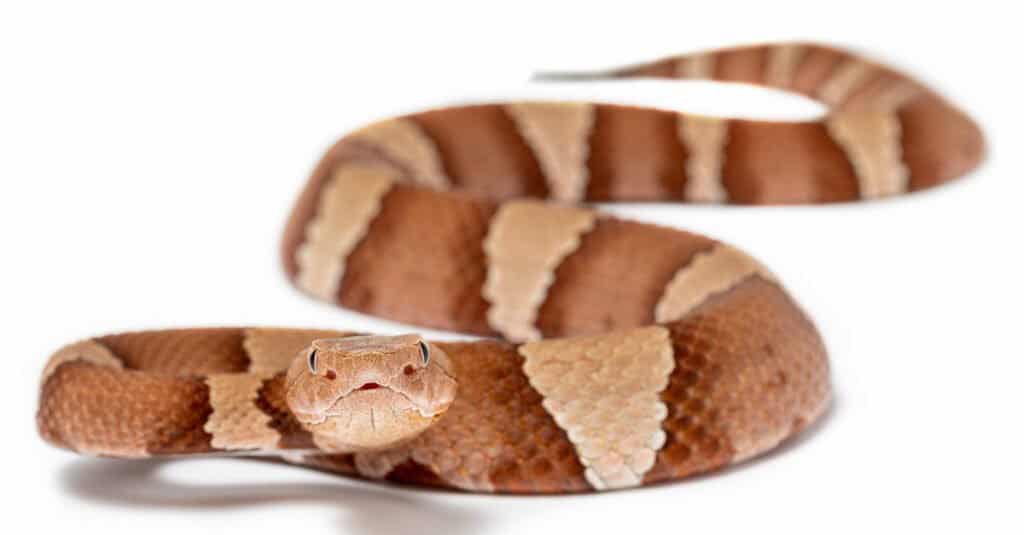
Broadbanded copperheads are venomous but never aggressive. They only bite if directly threatened or harassed.
©Scott Delony/Shutterstock.com
Western Diamondback Rattlesnake (Crotalus atrox)
This large rattlesnake may be able to reach seven feet long but usually averages four to five feet long. This species’ has rough diamond-shaped saddle markings that become black and white bands at the tail, right before the rattle. Western diamondback rattlesnakes have heavily keeled body scales, and their heads are covered in tiny scales that look like pebbles from a distance.
Notoriously nervous, the western diamondback rattlesnake tends to rattle from afar. If you give them enough space, they are more than happy to back away from you. These venomous pit vipers can deliver a dangerous venom quantity. However, very few rattlesnake bites in the U.S. are fatal, thanks to antivenom and medical care.
These snakes can be found along most of the Guadalupe River. While they aren’t semi-aquatic, like our next pit viper, western diamondback rattlesnakes are excellent swimmers and often take a dip when the outside temperatures rise.

Black and white tail bands are roughly even in width, ending in a well-developed rattle.
©Audrey Snider-Bell/Shutterstock.com
Cottonmouth (Agkistrodon piscivorus)
These snakes are more common in the lower Guadalupe River, where the water moves slower. Cottonmouths are the only semi-aquatic pit viper in the world. However fearsome their reputation, they lack aggression. These snakes have zero interest in you as anything other than a threat to their safety.
Cottonmouths get their name from the color of the inside of their mouth — white! The only reason you ever see the inside of their mouth is because they coil up, stay put, and fling their mouth open as a warning to keep away. Like copperheads, cottonmouths freeze when they sense a threat when on the land. In the water, they are likely to swim away to escape.
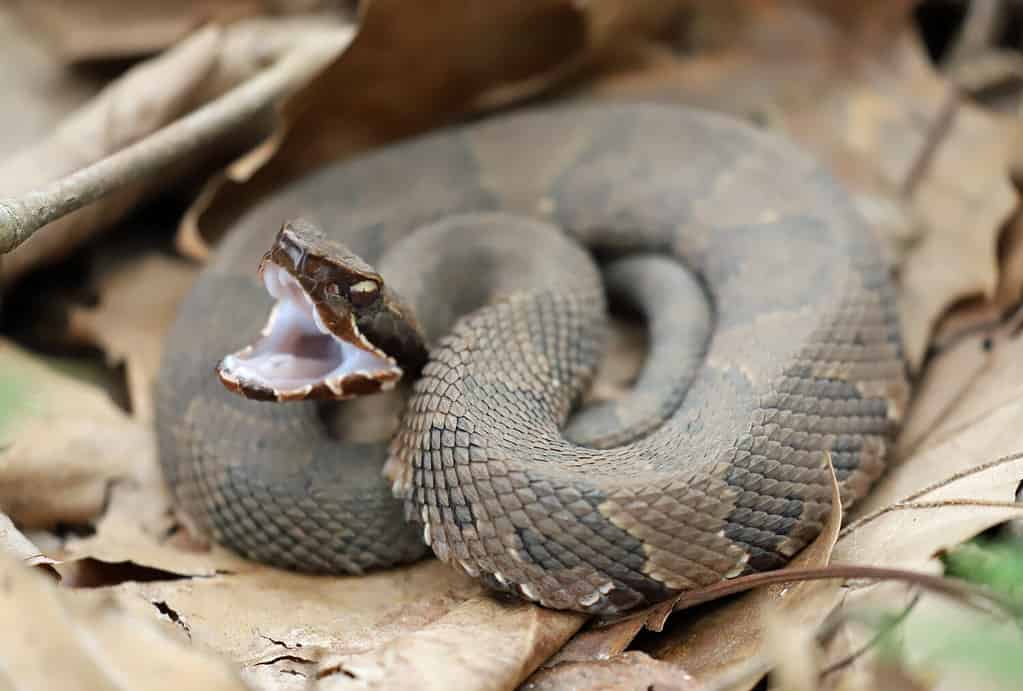
Although their pattern is similar to a copperhead, cottonmouths are semi-aquatic and try to warn you away by gaping their mouth.
©KF2017/Shutterstock.com
Texas Coral Snake (Micrurus tener)
Coral snakes are the only elapids in the United States. Of the three that occur, Texas only has one: the Texas coral snake. Before you worry, coral snakes are extremely reclusive and reluctant to bite. They grow up to 48 inches long with a thin pipe-shaped body. Texas coral snakes’ pattern is a black head, wide yellow band behind their eyes, followed by alternating bands of black, yellow, and red. A unique characteristic is that these snakes’ bands encircle their body.
Unlike the pit vipers along the Guadalupe River, coral snakes have round pupils. So don’t get lured in by pupil shape when determining whether you are looking at a venomous snake! Texas coral snakes are semi-fossorial, spending most of their time under moist leaf litter, and are rarely encountered.
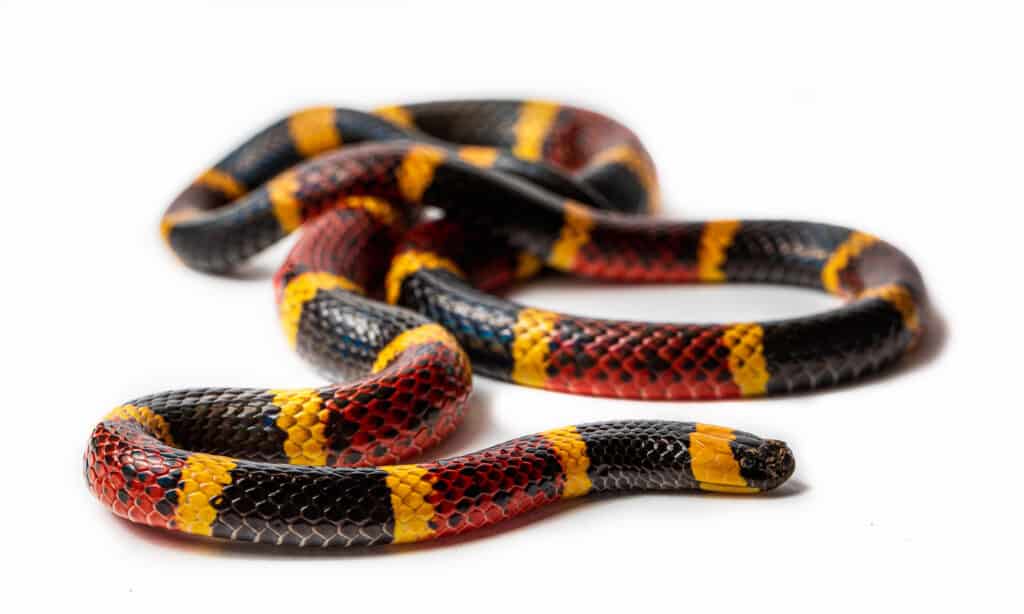
Texas coral snakes are extremely shy and only bite if they’re directly harassed.
©Scott Delony/Shutterstock.com
Other Animals In and Around the Guadalupe River in Texas
Snakes aren’t the only animals you might see around the Guadalupe River. This region is full of life — big and small. Coyotes, hawks, squirrels, and deer are common. Here are a few species native to the region.
- Gray Fox (Urocyon cinereoargenteus): The gray fox travels in small family units and eats small prey like rabbits and squirrels.
- Nine-Banded Armadillo (Dasypus novemcinctus): The most northern of all armadillos, the nine-banded armadillo is common across the southern United States.
- Eastern Bluebird (Sialia sialis): This small thrush thrives in the shrubs and open woodland along the Guadalupe River.
- Bobcat (Lynx rufus): These stealthy predators range far and wide. Although you may never see one, they probably see you.
| Snake | Venomous? |
|---|---|
| Plain-bellied watersnake | No, but their saliva contains an anticoagulant that makes you bleed more when they bite you. |
| Diamondback watersnake | No |
| Coachwhip | No |
| Texas ratsnake | No |
| Black-necked gartersnake | Mildly venomous saliva helps disable prey. |
| Western ribbon snake | Mildly venomous saliva helps disable prey. |
| Checkered garter snake | Mildly venomous saliva helps disable prey. |
| Eastern hognose snake | Mild, prey-specific venom |
| Rough earthsnake | No |
| Texas blind snake | No |
| Texas patchnose snake | No |
| Broad-banded copperhead | Yes! |
| Western diamondback rattlesnake | Yes! |
| Cottonmouth | Yes! |
| Texas coral snake | Yes! |
The photo featured at the top of this post is © JaDipity/Shutterstock.com
Discover the "Monster" Snake 5X Bigger than an Anaconda
Every day A-Z Animals sends out some of the most incredible facts in the world from our free newsletter. Want to discover the 10 most beautiful snakes in the world, a "snake island" where you're never more than 3 feet from danger, or a "monster" snake 5X larger than an anaconda? Then sign up right now and you'll start receiving our daily newsletter absolutely free.
Thank you for reading! Have some feedback for us? Contact the AZ Animals editorial team.






